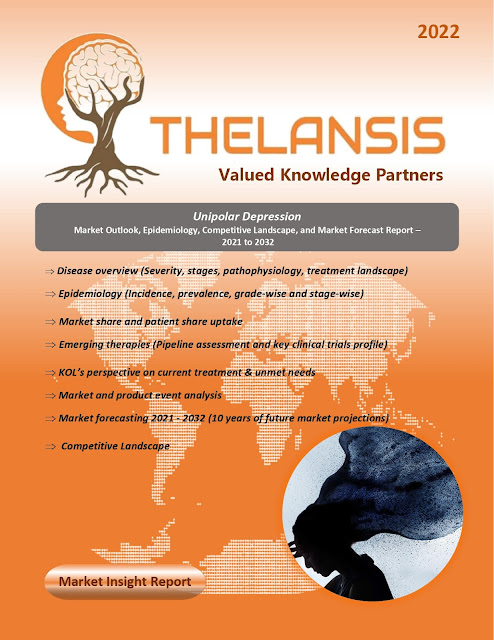Unipolar Depression – Market Outlook, Epidemiology, Competitive Landscape, and Market Forecast Report – 2021 To 2032
Unipolar depression as a standard and widespread illness is continually increasing. A combination of two symptoms characterises unipolar depression: emotional-cognitive and neurovegetative are directly related to the body (such as insomnia/hypersomnia, dysregulated eating, fatigue, and decreased energy). Morbidity risk for unipolar depression has been estimated between 13.9% and 18.4% in families diagnosed with the unipolar disease earlier. The unipolar designation indicates that depression does not alter between the two mood states. Unipolar depression can occur alongside several physical health issues, including cancer, physical trauma, chronic pain, cardiac problems, chronic health concern, and terminal stage illnesses. Some medications, such as interferon and beta-blocker treatments, can mimic or trigger depressive symptoms.
·
The prevalence of polar depression varies
widely in adults and elderly patients, from 3% in Japan, 11% in Britain, and
10% in the US.
Thelansis’s “Unipolar Depression
Market Outlook, Epidemiology, Competitive
Landscape, and Market Forecast Report – 2021 To 2032" covers disease
overview, epidemiology, drug utilization, prescription share analysis,
competitive landscape, clinical practice, regulatory landscape, patient share,
market uptake, market forecast, and key market insights under the potential Unipolar
Depression treatment modalities options for eight major markets (USA, Germany,
France, Italy, Spain, UK, Japan, and China).
KOLs insights
of Unipolar Depression across 8 MM market from the centre of Excellence/
Public/ Private hospitals participated in the study. Insights around current
treatment landscape, epidemiology, clinical characteristics, future treatment
paradigm, and Unmet needs.
Unipolar Depression Market Forecast Patient
Based Forecast Model (MS. Excel Based Automated Dashboard), which Data Inputs
with sourcing, Market Event, and Product Event, Country specific Forecast
Model, Market uptake and patient share uptake, Attribute Analysis, Analog
Analysis, Disease burden, and pricing scenario, Summary, and Insights.
Thelansis Competitive Intelligence (CI) practice
has been established based on a deep understanding of the pharma/biotech
business environment to provide an optimized support system to all levels of
the decision-making process. It enables business leaders in forward-thinking
and proactive decision-making. Thelansis supports scientific and commercial
teams in seamless CI support by creating an AI/ ML-based technology-driven
platform that manages the data flow from primary and secondary sources.




Comments
Post a Comment